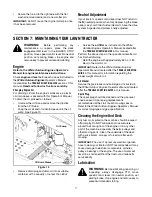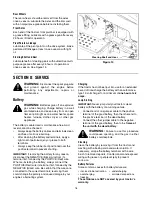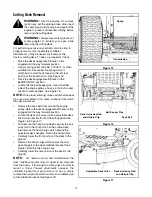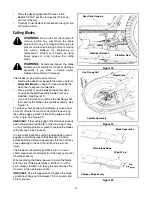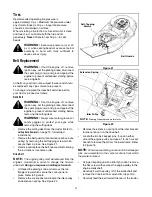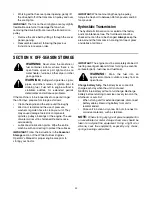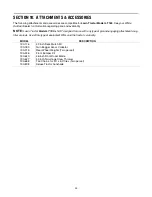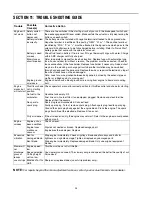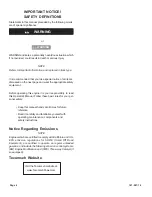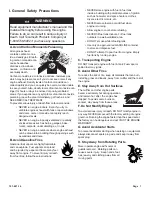
13
•
The lawn tractor is brought to a stop by depressing
the brake pedal.
•
Set the parking brake by fully depressing the brake
pedal and keeping it depressed while grasping the
parking brake knob and pulling it upward. Release
the brake pedal to allow the parking brake to
engage.
WARNING:
Before leaving the operator’s
position for any reason, disengage the
blades, place the speed control lever in
neutral, engage the parking brake, shut
engine off and remove the key.
IMPORTANT:
When stopping the tractor for any reason
while on a grass surface, always
•
Place the speed control lever in
N
(neutral),
•
Engage the parking brake,
•
Shut engine off and remove the key.
Doing so will minimize the possibility of having your
lawn ‘‘browned’’ by hot exhaust from your tractor’s
running engine.
Engaging The Cutting Blades
WARNING:
Keep feet and hands away
from the discharge opening, the blades or
any part of the deck. When the unit is used
for anything other than mowing operations,
the blade drive should be disengaged.
To engage power to the cutting deck or other
(separately available) attachment, proceed as follows:
•
Move the deck engagement/lift lever to the right
and forward and place it in a notch for your desired
cutting height.
•
Moving the lever to the right and all the way
rearward (into the BLADES STOP position) raises
and disengages power to the cutting deck.
NOTE:
The deck engagement/lift lever
must
be in the
BLADES STOP position when starting the engine,
when traveling in reverse and if the operator leaves the
seat. Refer to
Safety Interlock Switches
on page 11
Moving The Tractor Manually
Your tractor’s transmission is equipped with a
hydrostatic relief valve for occasions when it is
necessary to move the tractor manually. Activating this
valve forces the fluid in the transmission to bypass its
normal route, allowing the rear tires to "freewheel." To
engage the hydrostatic relief valve, proceed as follows:
•
Locate the hydrostatic bypass rod in the rear of the
tractor. See Figure 6.
•
Pull the hydrostatic bypass rod outward, then up
and to the right, to lock it in place.
Figure 6
NOTE:
The transmission will NOT engage when the
hydrostatic bypass rod is pulled out. Return the rod to
its normal position prior to operating the tractor.
IMPORTANT:
Never attempt to move the tractor
manually without first engaging the hydrostatic relief
valve. Doing so will result in serious damage to the
tractor’s transmission.
Mowing
WARNING:
To help avoid blade contact or
a thrown object injury, keep bystanders,
helpers, children and pets at least 75 feet
from the machine while it is in operation. Stop
machine if anyone enters the area.
The following information will be helpful when using the
cutting deck with your tractor.
WARNING:
Plan your mowing pattern to
avoid discharge of materials toward roads,
sidewalks, bystanders and the like. Also,
avoid discharging material against a wall or
obstruction which may cause discharged
material to ricochet back toward the operator.
•
Be sure that the lawn is clear of stones, sticks, wire,
or other objects which could damage lawn mower
or engine.
•
For best results and to insure more even grass
distribution, do not mow when lawn is excessively
wet.
•
Do not mow at high ground speed, especially if a
mulch kit or grass collector is installed.
•
For best results it is recommended that the first two
laps be cut with the discharge thrown towards the
center.
Hydrostatic
Bypass Rod

















